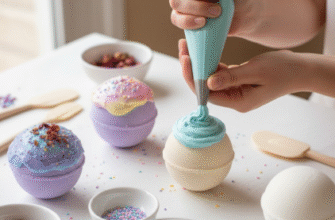Tired of scratchy clothes and that faint chemical smell clinging to your laundry? Many people reach for dryer sheets or liquid fabric softeners without a second thought, but there’s a growing movement towards simpler, more natural laundry solutions. Enter the humble wool dryer ball. These unassuming little spheres are fantastic alternatives, helping to soften fabrics, reduce static cling, and even shorten drying times. Best of all, you can easily make your own and customize them with your favourite natural scents using essential oils.
Making the switch from commercial dryer sheets offers several appealing benefits. Firstly, it’s a win for your wallet. A set of wool dryer balls can last for hundreds, even thousands, of loads, whereas single-use sheets need constant replacing. Secondly, it’s an environmentally friendlier choice. You’re eliminating the waste generated by disposable sheets and avoiding the complex chemicals often found in liquid softeners, which can coat fabrics and even irritate sensitive skin. Homemade wool dryer balls are reusable, biodegradable, and completely natural.
Why Choose Wool for Dryer Balls?
You might wonder why wool is the go-to material. It comes down to the unique properties of wool fibres. Wool is incredibly absorbent, meaning it can help soak up some moisture from your wet clothes in the dryer, potentially speeding up the drying process. As the balls tumble around with your laundry, they physically separate the items, allowing hot air to circulate more efficiently. This agitation also helps to naturally soften fabrics by gently beating against the fibres, much like fluffing pillows.
Furthermore, wool has natural anti-static properties, although results can vary depending on humidity levels and fabric types. The key is using 100% wool yarn. Blends containing acrylic, cotton, or other synthetic materials simply won’t felt properly. Felting is the process where the wool fibres mat and lock together, creating a dense, durable ball that won’t unravel in the dryer. Non-wool fibres lack the microscopic scales that allow wool to felt so effectively when exposed to heat, moisture, and agitation.
Crafting Your Own Wool Dryer Balls: A Simple DIY Project
Ready to give it a try? Making your own wool dryer balls is surprisingly straightforward and requires minimal materials. It’s a great project for a quiet afternoon.
Materials You’ll Need:
- 100% Wool Yarn: This is non-negotiable! Look for yarn explicitly labelled “100% Wool.” Avoid anything marked “superwash,” as this type of wool is treated to prevent felting. Worsted weight is a good choice, but other weights work too. One standard skein typically makes 2-4 balls, depending on the size you want.
- Scissors: For cutting the yarn.
- Old Pantyhose or Stockings: Knee-highs work perfectly. You’ll use these to keep the balls separate during the felting wash.
- Washing Machine & Dryer: Essential for the felting process.
- Optional: Essential Oils: For adding natural fragrance later.
Step-by-Step Instructions:
1. Start Winding: Find the end of your wool yarn. Wrap it around two fingers several times. Slip the loops off your fingers and begin wrapping the yarn tightly around this small bundle, forming the core of your ball. Keep wrapping, changing direction frequently to create a spherical shape rather than a flat disc. Maintain consistent, firm tension – a tightly wound ball felts better and lasts longer.
2. Build the Ball: Continue wrapping the yarn around the core, pressing it firmly as you go. Aim for a ball roughly the size of a tennis ball, or slightly larger, as it will shrink a bit during felting. Once you reach the desired size, cut the yarn, leaving a tail of a few inches.
3. Secure the End: Using your fingers or a crochet hook (if you have one handy), carefully tuck the end of the yarn deep underneath several strands on the surface of the ball. Make sure it’s securely tucked away so it doesn’t unravel during washing.
4. Prepare for Felting: Repeat steps 1-3 to make as many balls as you like (a set of 3-6 is typical). Carefully slide one yarn ball down into the toe of a pantyhose leg. Tie a tight knot directly above the ball, or use a piece of string, to keep it snug. Add the next ball, tie another knot, and continue until all your balls are encased in the pantyhose, resembling a string of lumpy sausages. This prevents them from sticking together during the wash.
5. The Felting Wash: Toss the pantyhose-encased yarn balls into your washing machine with a load of sturdy items like towels or jeans (don’t wash them alone, as they need items to bounce off). Use the hottest water setting available on your machine and run a regular wash cycle. Use a small amount of detergent if you like, though it’s not strictly necessary for felting. The combination of hot water, soap (if used), and agitation causes the wool fibres to open up, tangle, and lock together – this is felting!
6. Drying and Checking: After the wash cycle, carefully remove the balls from the pantyhose (you might need scissors to cut the knots). They should look fuzzy and feel denser, with the individual strands of yarn less defined. Now, toss them into your dryer on a high heat setting along with the towels or jeans. Dry them completely. Once dry, inspect the balls. If they still look very yarn-like and not sufficiently matted, repeat the hot wash and dry cycle (steps 5 & 6). Sometimes it takes two or even three cycles to achieve a good felt.
Verified Felting Facts: The felting process relies on three key elements: heat, moisture, and agitation. Hot water causes the microscopic scales on wool fibres to open up. Agitation (from the washing machine) makes the fibres rub against each other, tangling them. As they cool and dry, these scales lock together, creating a dense, non-woven fabric – felt!
Adding Natural Fragrance with Essential Oils
Once your wool dryer balls are fully felted and completely dry, you can introduce the delightful aspect of natural scent using essential oils. This allows you to customize your laundry’s fragrance without synthetic chemicals.
How to Apply Essential Oils:
The process is incredibly simple. Take one dry wool ball and add 2-4 drops of your chosen essential oil directly onto its surface. Repeat for each ball you plan to use in the load. It’s crucial to let the balls sit for at least 20-30 minutes (longer is even better) after applying the oil, allowing it to soak in thoroughly before tossing them into the dryer with your wet clothes. This helps distribute the scent more evenly and minimizes the chance of oil transferring directly onto fabrics, which could potentially cause spots (especially with darker oils).
Important: Add the essential oils to the *dry* balls *before* starting the drying cycle with wet clothes. Do not add oils mid-cycle or to wet balls.
Choosing Your Scents:
The world of essential oils offers a vast palette of fragrances! Here are some popular choices for laundry:
- Lavender: Calming, relaxing, classic floral scent. Great for bedding and towels.
- Lemon: Bright, fresh, clean, and uplifting. Excellent for everyday clothes.
- Orange (Sweet or Wild): Cheerful, citrusy, and invigorating.
- Peppermint: Cool, minty, and refreshing. Good for workout clothes or towels.
- Eucalyptus: Clean, crisp, and slightly medicinal. Often used for bedding when feeling stuffy.
- Grapefruit: Zesty, bright citrus scent.
- Tea Tree: Known for its cleansing properties, has a distinct medicinal aroma. Use sparingly or blend it.
- Cedarwood or Fir Needle: Earthy, woodsy scents.
Feel free to get creative and blend oils! Lavender and Lemon make a lovely fresh floral blend. Orange and Peppermint create an energizing mix. Experiment to find combinations you adore.
Important Considerations: Always use 100% pure essential oils, not fragrance oils, which are synthetic. Be mindful that some darker oils (like patchouli or blue tansy) have a higher potential to stain light-coloured fabrics if not allowed to fully absorb into the ball first. Start with fewer drops if you have sensitive skin, as trace amounts might transfer to clothing. Ensure the yarn used is strictly 100% wool, as synthetic blends will not felt properly and the balls will likely unravel.
Using and Maintaining Your Scented Dryer Balls
Using your new homemade dryer balls couldn’t be easier. Simply toss 3 to 6 balls into the dryer along with your wet laundry. For smaller loads, 3-4 balls are usually sufficient. For larger loads or heavy items like towels and jeans, using 5-6 balls provides more surface area for tumbling and air circulation.
You should notice several benefits: * Faster Drying: The balls help separate clothes, improving airflow and reducing overall drying time, saving energy. * Softer Clothes: The gentle tumbling action naturally softens fabrics without chemical coatings. * Reduced Static: While not always eliminating it 100% (especially in very dry conditions), well-felted wool balls significantly reduce static cling compared to having none. * Gentle Scent: A subtle, natural fragrance imparted by the essential oils.
The scent from the essential oils will typically last for 2-5 loads, depending on the oil used and the size of your loads. When you notice the fragrance fading, simply reapply a few drops to each ball, let them sit, and they’re ready for the next cycle. The wool balls themselves are incredibly durable and should last for years. If they start to look a bit fuzzy or pilled over time, you can give them another hot wash and dry cycle (without adding more yarn) to tighten them up again.
Troubleshooting Common Issues
Balls Unraveling? This usually means they weren’t felted enough initially. Ensure you used 100% non-superwash wool and run them through one or two more hot wash/high heat dry cycles.
Still Lots of Static? Make sure the balls are well-felted and dense. Over-drying clothes can also increase static; try reducing the drying time slightly. Some people find pinning a single safety pin to one ball helps dissipate static, but ensure it’s securely fastened.
Scent Too Weak or Too Strong? Adjust the number of drops per ball. Remember to let the oil absorb fully before drying.
Oil Spots on Clothes? This is rare but can happen with darker oils or if the oil wasn’t allowed to absorb. Try using fewer drops, letting the balls sit longer after application, or switching to lighter-coloured oils like lavender or lemon.
Embrace Natural Laundry Care
Making and using homemade wool dryer balls with essential oils is a simple, rewarding way to make your laundry routine more natural, economical, and enjoyable. You reduce waste, avoid harsh chemicals, save energy, and get to customize the scent of your freshly dried clothes. It’s a small change that makes a noticeable difference, turning a mundane chore into a slightly more pleasant, fragrant experience. Give it a try – your clothes, your wallet, and the planet might just thank you.








